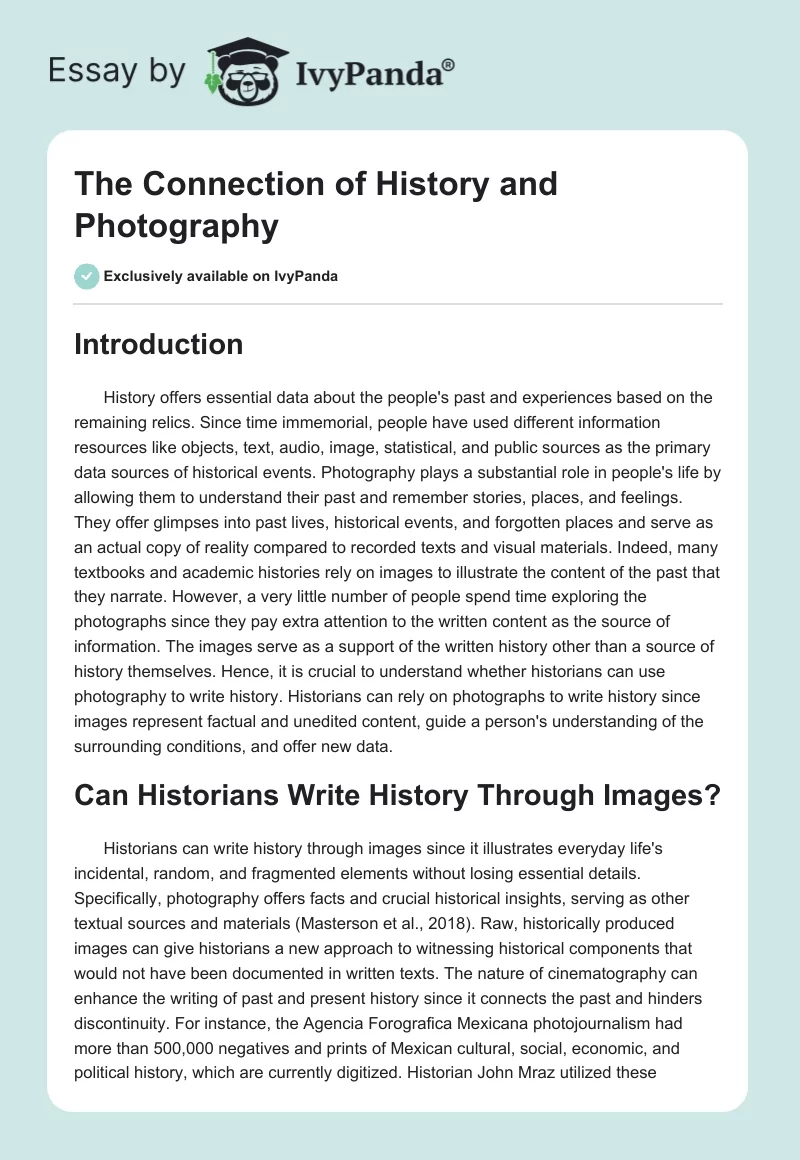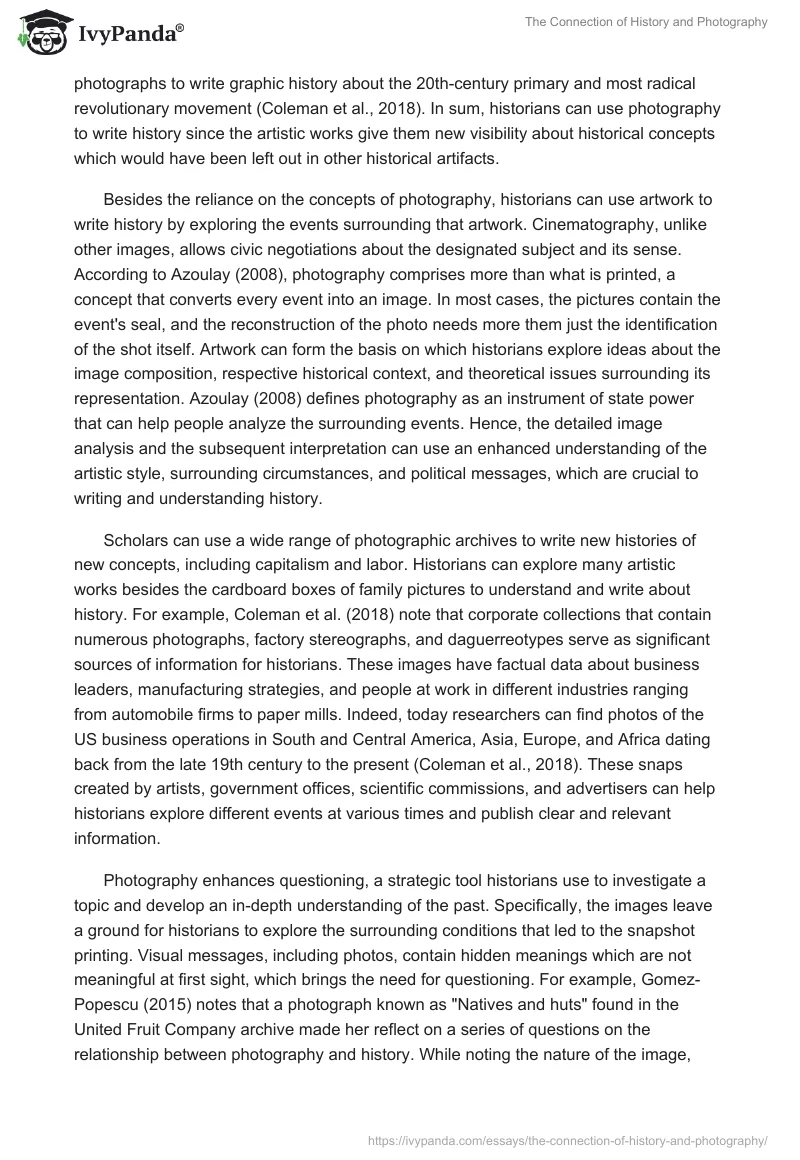Introduction
History offers crucial data about the people’s past and experiences based on the remaining relics. Since time immemorial, people have used different information aids like objects, text, audio, images, statistical, and public sources as the primary data sources of historical events.
Photography plays a substantial role in people’s life by allowing them to understand their past and remember stories, places, and feelings. They offer glimpses into past lives, historical events, and forgotten places and serve as an actual copy of reality compared to recorded texts and visual materials. Indeed, many textbooks and academic histories rely on images to illustrate the content of the past that they narrate. However, a very little number of people spend time exploring the photographs since they pay extra attention to the written content as the source of information.
The images serve as a support of the written history other than a source of history themselves. Hence, it is crucial to understand whether historians can use photography to write history. Historians can rely on photographs to write history since images represent factual and unedited content, guide a person’s understanding of the surrounding conditions, and offer new data.
Can Historians Write History Through Images?
Historians can write history through images since it illustrates everyday life’s incidental, random, and fragmented elements without losing essential details. Specifically, photography offers facts and crucial historical insights, serving as other textual sources and materials (Masterson et al., 2018). Raw, historically produced images can give historians a new approach to witnessing historical components that would not have been documented in written texts. The nature of cinematography can enhance the writing of past and present history since it connects the past and hinders discontinuity.
For instance, the Agencia Forografica Mexicana photojournalism had more than 500,000 negatives and prints of Mexican cultural, social, economic, and political history, which are currently digitized. Historian John Mraz utilized these photographs to write graphic history about the 20th-century primary and most radical revolutionary movement (Coleman et al., 2018). In sum, historians can use photography to write history since the artistic works give them new visibility about historical concepts which would have been left out in other historical artifacts.
Besides the reliance on the concepts of photography, historians can use artwork to write history by exploring the events surrounding that artwork. Cinematography, unlike other images, allows civic negotiations about the designated subject and its sense. According to Azoulay (2008), photography comprises more than what is printed, a concept that converts every event into an image. In most cases, the pictures contain the event’s seal, and the reconstruction of the photo needs more them just the identification of the shot itself.
Artwork can form the basis on which historians explore ideas about the image composition, respective historical context, and theoretical issues surrounding its representation. Azoulay (2008) defines photography as an instrument of state power that can help people analyze the surrounding events. Hence, the detailed image analysis and the subsequent interpretation can use an enhanced understanding of the artistic style, surrounding circumstances, and political messages, which are crucial to writing and understanding history.
Scholars can use a wide range of photographic archives to write new histories of new concepts, including capitalism and labor. Historians can explore many artistic works besides the cardboard boxes of family pictures to understand and write about history. For example, Coleman et al. (2018) note that corporate collections that contain numerous photographs, factory stereographs, and daguerreotypes serve as significant sources of information for historians. These images have factual data about business leaders, manufacturing strategies, and people at work in different industries ranging from automobile firms to paper mills.
Indeed, today researchers can find photos of the US business operations in South and Central America, Asia, Europe, and Africa dating back from the late 19th century to the present (Coleman et al., 2018). These snaps created by artists, government offices, scientific commissions, and advertisers can help historians explore different events at various times and publish clear and relevant information.
Photography enhances questioning, a strategic tool historians use to investigate a topic and develop an in-depth understanding of the past. Specifically, the images leave a ground for historians to explore the surrounding conditions that led to the snapshot printing. Visual messages, including photos, contain hidden meanings which are not meaningful at first sight, which brings the need for questioning. For example, Gomez-Popescu (2015) notes that a photograph known as “Natives and huts” found in the United Fruit Company archive made her reflect on a series of questions on the relationship between photography and history.
While noting the nature of the image, Gomez-Popescu (2015) realized that the 19th century witnessed new impulses, new documentation forms, and the anchoring of the business to people, times, places, and artifacts. Hence, this picture became a document due to the firm’s archival practices of gathering, ordering, storing, and preserving it. A detailed investigation of the image’s origin and events would lead to discovering additional information, which is vital for writing history. Altogether, historians questioning the circumstances surrounding the production and documentation of a specific image can generate critical and significant historical data.
The photographic medium contains an aesthetic principle of realism: revelation, representation, and penetration of physical reality. An artist known as Kracauer defines photography as raw and uncooked daily living that can be incomplete, unconditional, and indeterminacy (Linneberg, 2022).
The features of camerawork, like camera reality, match those of historical fact that is partial, uncertain, and ambiguous. Professional photographers who maintain raw images can significantly contribute to historical development and analysis. Ultimately, photograph serves as a data source that, other than confronting us with the truth, ideologies, and meaning, serve as intermediary materials to trigger critical thinking and conceptualization.
Conclusion
Overall, photography falls under the visual sources of chronological data that historians can use to understand and write about recorded events. Specifically, images offer raw and unedited data that allow historians to understand the events depicted in the printing and the surrounding circumstances. However, a direct relationship between photography and history occurs when the subjects understand the image as a historical reflection whose meaning emerges after interpretation.
Indeed, many historians use images to explore the past by questioning the occasions surrounding taking the picture, the photographer’s motives, and intentions. Although many rely on written texts to understand and write history, cinematography highlights minor but significant details about historical moments. Over time, historians have proven to use this data to write about new historical events or improve on published data.
With its ability to capture some features, which remain unnoticed in written history, scholars can rely on these printings to expand on the existing historical data and develop new understanding levels. Thus, photography significantly influences history writing, and artists should continue producing raw images that can help future historians write the current events.
References
Azoulay, A. (2008). The civil contract of photography. Princeton University Press.
Coleman, K., James, D., & Sharma, J. (2018). Photography and work. Radical History Review, 2018(132), 1-22.
Gomez-Popescu, L. (2015). Epilogue: Archive matters. Estudios Interdisciplinarios de America Latina y el Caribe, 26(2), 95-103.
Linneberg, A. (2022). Legal narratives as imaginary constructions: Siegfried Kracauer, historiography and law’s stories. Erzahlen und Recht/Narrative and Law, 12, 181.
Masterson, V. A., Mahajan, S. L., & Tengo, M. (2018). Photovoice for mobilizing insights on human well-being in complex social-ecological systems. Ecology and Society, 23(3).


